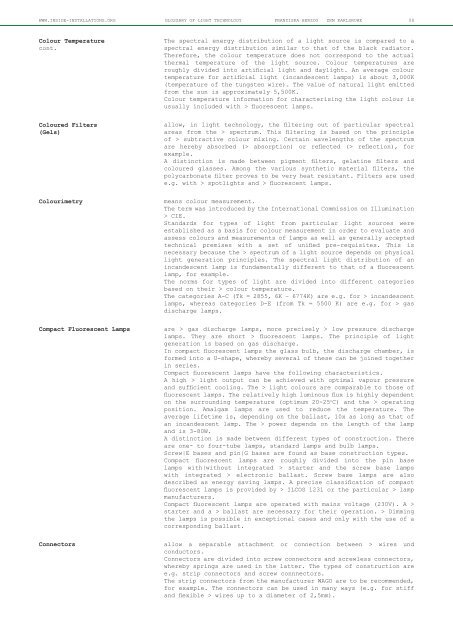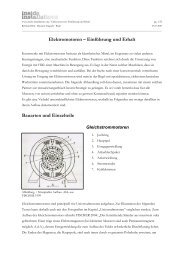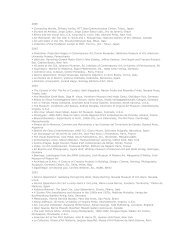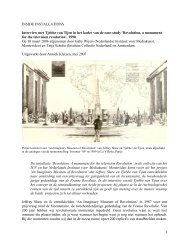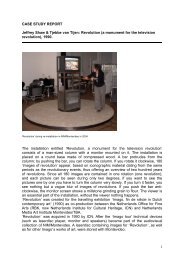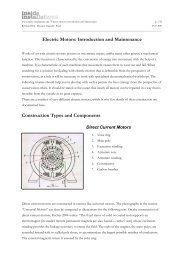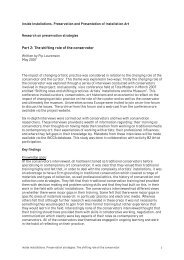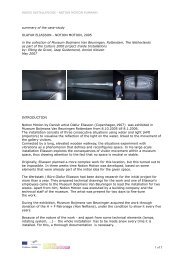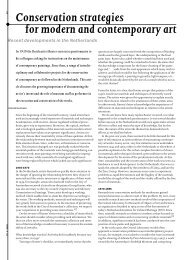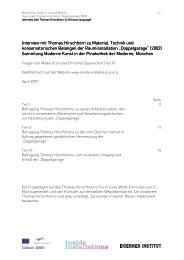GLOSSARY OF LIGHT TECHNOLOGY - Inside Installations
GLOSSARY OF LIGHT TECHNOLOGY - Inside Installations
GLOSSARY OF LIGHT TECHNOLOGY - Inside Installations
Create successful ePaper yourself
Turn your PDF publications into a flip-book with our unique Google optimized e-Paper software.
WWW.INSIDE-INSTALLATIONS.ORG <strong>GLOSSARY</strong> <strong>OF</strong> <strong>LIGHT</strong> <strong>TECHNOLOGY</strong> FRANZISKA HERZOG ZKM KARLSRUHE 08<br />
Colour Temperature<br />
cont.<br />
Coloured Filters<br />
(Gels)<br />
Colourimetry<br />
Compact Fluorescent Lamps<br />
Connectors<br />
The spectral energy distribution of a light source is compared to a<br />
spectral energy distribution similar to that of the black radiator.<br />
Therefore, the colour temperature does not correspond to the actual<br />
thermal temperature of the light source. Colour temperatures are<br />
roughly divided into artificial light and daylight. An average colour<br />
temperature for artificial light (incandescent lamps) is about 3,000K<br />
(temperature of the tungsten wire). The value of natural light emitted<br />
from the sun is approximately 5,500K.<br />
Colour temperature information for characterising the light colour is<br />
usually included with > fluorescent lamps.<br />
allow, in light technology, the filtering out of particular spectral<br />
areas from the > spectrum. This filtering is based on the principle<br />
of > subtractive colour mixing. Certain wavelengths of the spectrum<br />
are hereby absorbed (> absorption) or reflected (> reflection), for<br />
example.<br />
A distinction is made between pigment filters, gelatine filters and<br />
coloured glasses. Among the various synthetic material filters, the<br />
polycarbonate filter proves to be very heat resistant. Filters are used<br />
e.g. with > spotlights and > fluorescent lamps.<br />
means colour measurement.<br />
The term was introduced by the International Commission on Illumination<br />
> CIE.<br />
Standards for types of light from particular light sources were<br />
established as a basis for colour measurement in order to evaluate and<br />
assess colours and measurements of lamps as well as generally accepted<br />
technical premises with a set of unified pre-requisites. This is<br />
necessary because the > spectrum of a light source depends on physical<br />
light generation principles. The spectral light distribution of an<br />
incandescent lamp is fundamentally different to that of a fluorescent<br />
lamp, for example.<br />
The norms for types of light are divided into different categories<br />
based on their > colour temperature.<br />
The categories A-C (Tk = 2855, 6K – 6774K) are e.g. for > incandescent<br />
lamps, whereas categories D-E (from Tk = 5500 K) are e.g. for > gas<br />
discharge lamps.<br />
are > gas discharge lamps, more precisely > low pressure discharge<br />
lamps. They are short > fluorescent lamps. The principle of light<br />
generation is based on gas discharge.<br />
In compact fluorescent lamps the glass bulb, the discharge chamber, is<br />
formed into a U-shape, whereby several of these can be joined together<br />
in series.<br />
Compact fluorescent lamps have the following characteristics.<br />
A high > light output can be achieved with optimal vapour pressure<br />
and sufficient cooling. The > light colours are comparable to those of<br />
fluorescent lamps. The relatively high luminous flux is highly dependent<br />
on the surrounding temperature (optimum 20-25 o C) and the > operating<br />
position. Amalgam lamps are used to reduce the temperature. The<br />
average lifetime is, depending on the ballast, 10x as long as that of<br />
an incandescent lamp. The > power depends on the length of the lamp<br />
and is 3-80W.<br />
A distinction is made between different types of construction. There<br />
are one- to four-tube lamps, standard lamps and bulb lamps.<br />
Screw|E bases and pin|G bases are found as base construction types.<br />
Compact fluorescent lamps are roughly divided into the pin base<br />
lamps with|without integrated > starter and the screw base lamps<br />
with integrated > electronic ballast. Screw base lamps are also<br />
described as energy saving lamps. A precise classification of compact<br />
fluorescent lamps is provided by > ILCOS 1231 or the particular > lamp<br />
manufacturers.<br />
Compact fluorescent lamps are operated with mains voltage (230V). A ><br />
starter and a > ballast are necessary for their operation. > Dimming<br />
the lamps is possible in exceptional cases and only with the use of a<br />
corresponding ballast.<br />
allow a separable attachment or connection between > wires und<br />
conductors.<br />
Connectors are divided into screw connectors and screwless connectors,<br />
whereby springs are used in the latter. The types of construction are<br />
e.g. strip connectors and screw connnectors.<br />
The strip connectors from the manufacturer WAGO are to be recommended,<br />
for example. The connectors can be used in many ways (e.g. for stiff<br />
and flexible > wires up to a diameter of 2,5mm).


